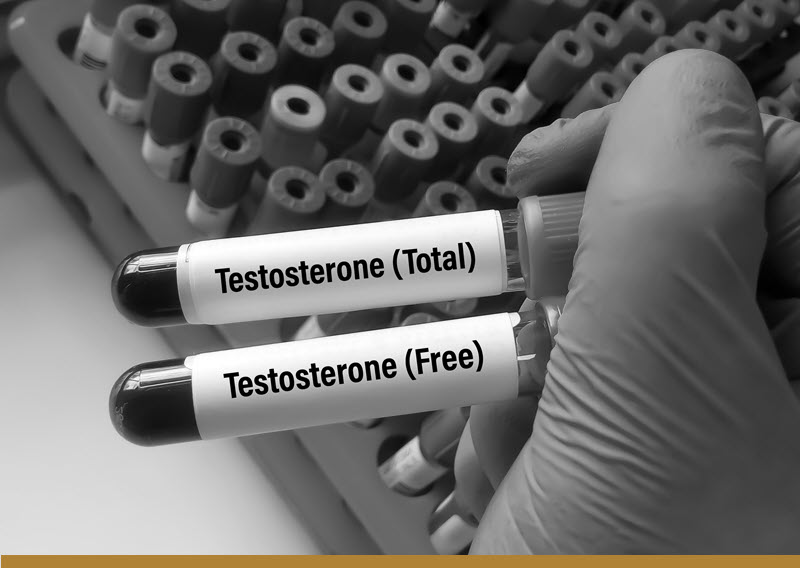Testosterone is the primary androgen, the hormone responsible for the development of male sexual characteristics. It is also present in women in smaller amounts. It regulates various bodily processes in both sexes, from reproductive function and sex drive to muscle growth and fat accumulation.
Insufficient or excessive testosterone levels can disrupt these vital processes and lead to medical conditions. People experiencing symptoms of a testosterone imbalance should seek treatment and the first step in this direction is to establish testosterone levels. This is done via tests that measure total or free testosterone in the blood.
This article explains the difference between free testosterone vs. total testosterone, how they are measured, and recommends ways to improve their levels.

Free or unbound testosterone is the testosterone in the blood that is not attached to any protein. It freely circulates and is easily available for use by cells and tissues. Free testosterone usually comprises 2-3% of the total testosterone in circulation.
Total testosterone shows the level of free and bound hormones in the blood.
Bound testosterone is attached to two types of proteins: sex hormone-binding globulin (SHBG) and albumin. These proteins help regulate testosterone levels and how the body uses the hormone.
SHBG-bound testosterone is generally considered biologically inactive. This is because the strong binding affinity of SHBG makes it difficult for the testosterone to dissociate and become available. This type of bound testosterone acts as reservoir, controlling the amount of free testosterone readily available for biological activity.
Testosterone bound to albumin is loosely attached to the protein, allowing it to detach and enter cells. When this happens, it becomes free testosterone. Albumin-bound and free testosterone are also called bioavailable as they are ready to enter tissues and perform their physiological functions.
Free and total testosterone are the same hormone. The only difference is in their bioavailability.
When the pituitary gland stimulates the release of testosterone in the blood, free testosterone can immediately enter cells, enabling them to perform their function. The remaining testosterone stays in the bloodstream bound to proteins SHBG and albumin, maintaining a steady reserve.
Total testosterone is mostly made up of SHBG-bound hormone, which has limited biological activity. However, SGBH-bound testosterone ensures a consistent supply of the hormone and prevents its rapid degradation. Total testosterone also includes markers for bioavailable hormones – free and albumin-bound testosterone.
Testosterone regulates the following bodily functions:
Free testosterone unlocks these processes when it enters the cells and binds to androgen receptors.
Patients can have symptoms of hypogonadism (low testosterone) if either total, free, or both types of hormones are low. They include:
Note: Low sex drive in men in a treatable condition. Does testosterone increase low sex drive? Read our article and find out.
It is possible to have normal total testosterone levels and low free testosterone. This usually occurs when SHBG levels increase, which happens with age.
When SHGB levels decline, patients can have normal free testosterone levels and low total testosterone. This situation can happen in people with diabetes.
In most cases, when total testosterone is low, free testosterone is low as well.
Doctors order testosterone tests for patients with suspected low or elevated testosterone levels.
These are blood tests and they are usually performed around 8-10 am because testosterone concentrations peak at this time. If taken later in the day, the test can show a misleadingly low score.
The doctor uses a sterile needle to draw blood from the patient’s arm vein, which may sting a little. They transfer the blood into a test tube or vial and send it to the lab for analysis. Taking the blood sample takes about five minutes. Patients are usually advised not to eat for several hours before the test.
There are also at-home testosterone test kits that allow patients to take the blood or saliva at home and send it to a lab for analysis. They receive the results in several days.
Total testosterone test
Patients with symptoms of a testosterone imbalance are usually told to take the total testosterone test first. It measures testosterone levels, including bioavailable and bound hormones. If the results confirm a hormonal imbalance or if doctors can’t make a diagnosis based on total T results, they may also request a free testosterone test.
Note: Read our article and find out more about total testosterone test.
Free testosterone test
The free testosterone test is less common than the total T test. It is usually prescribed when the doctor suspects a misleading total T score or the patient has symptoms of a hormonal imbalance, but the total T test shows normal hormone levels.
There are three methods of measuring free testosterone:
Free testosterone index in women
The free testosterone index is a measurement calculated after obtaining results from a total testosterone test. It measures the ratio between total testosterone and SHBG. It is only used in women with symptoms of abnormal testosterone levels, such as are seen in patients with polycystic ovarian syndrome (PCOS) or an ovarian tumor. The free testosterone index is known to correlated with free testosterone values.
Note: Learn more about testosterone therapy for women and how it helps relieve symptoms such as hot flashes, low libido, and insomnia.
The cost of a testosterone test depends on many factors, from the type of test to the lab’s location. In many cases, the patient’s insurance covers it. Contact our medical professionals at Vibrant Vitality Clinic in Phoenix to find out more about testosterone testing and pricing.
Testosterone levels depend on the patient’s sex, age, and health status. There are no universally recognized normal testosterone values because of the challenges in accurately measuring them. However, some generally accepted reference ranges are used in clinical practice.
Total Testosterone
Normal total testosterone levels typically fall within the following ranges:
After 40, total testosterone levels gradually decline at about 1% per year. It's important for healthcare providers to interpret total testosterone levels within the context of other health factors of the individual patient.
Free Testosterone
Free testosterone is usually calculated based on total testosterone and SHBG levels. It comprises 2-3% of total testosterone, and values lower or higher than that may point to a medical concern.
Free testosterone levels depend on total testosterone and SHBG levels. Implementing healthier lifestyle habits can help balance all testosterone levels and improve symptoms of a hormonal imbalance.
If your testosterone is low, there are several natural ways to enhance it:
Note: Find out how to lower cortisol levels and improve the quality of your life.
Doctors prescribe testosterone therapy to patients with more severe symptoms of low testosterone. It involves receiving injections, transdermal, or oral medications, which significantly improve symptoms.
If your testosterone levels are high, you may need to change medication or check for an underlying medical condition that is causing it.
A testosterone imbalance can disrupt essential bodily functions and cause uncomfortable symptoms. Measuring total and free testosterone levels is vital to understanding the symptoms and finding adequate treatment.
If you suspect you have abnormal total or free testosterone levels, get help from our medical professionals at Vibrant Vitality Clinic, with years of experience treating hormonal imbalances.




4325 E Indian School Rd, Suite 130
Phoenix, AZ 85018
United States
(480) 422-2058
info@vibrantvitalityclinic.com
Monday - Friday: 9:00 am - 6:00 pm
Saturday: 9:00 am - 3:00 pm
Sunday: Closed
